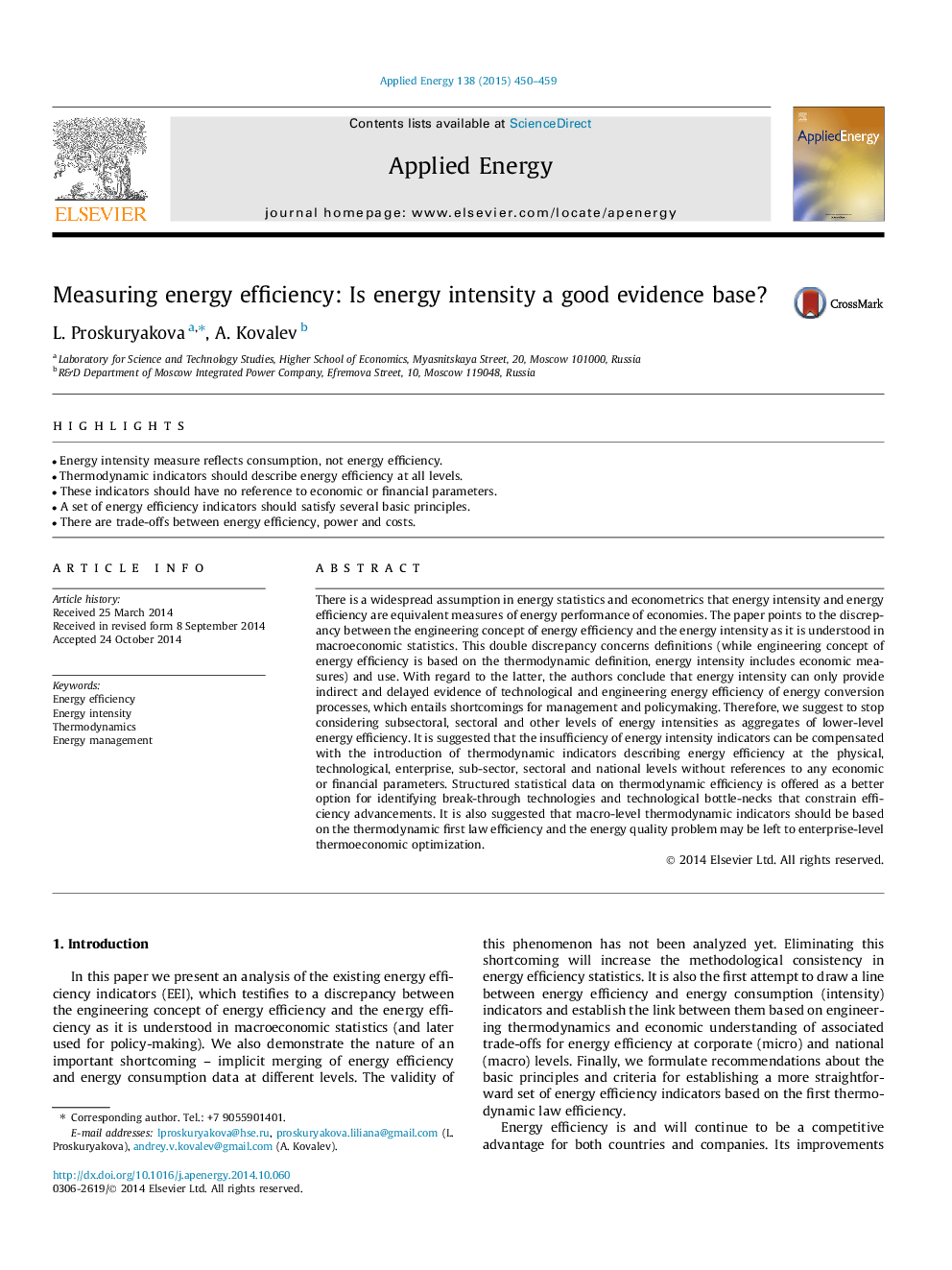| کد مقاله | کد نشریه | سال انتشار | مقاله انگلیسی | نسخه تمام متن |
|---|---|---|---|---|
| 6688342 | 501886 | 2015 | 10 صفحه PDF | دانلود رایگان |
عنوان انگلیسی مقاله ISI
Measuring energy efficiency: Is energy intensity a good evidence base?
ترجمه فارسی عنوان
ارزیابی راندمان انرژی: آیا شدت انرژی یک پایگاه مبتنی بر شواهد خوب است؟
دانلود مقاله + سفارش ترجمه
دانلود مقاله ISI انگلیسی
رایگان برای ایرانیان
کلمات کلیدی
بهره وری انرژی، شدت انرژی، ترمودینامیک، مدیریت انرژی،
ترجمه چکیده
یک فرض گسترده در آمار انرژی و اقتصاد سنجی وجود دارد که شدت انرژی و بهره وری انرژی معادل ارزیابی عملکرد انرژی در اقتصاد است. این مقاله به تفاوت بین مفهوم مهندسی بهره وری انرژی و شدت انرژی اشاره می کند که در آمار اقتصاد کلان قابل درک است. این اختلاف دوگانه در مورد تعاریف (در حالی که مفهوم مهندسی بهره وری انرژی بر اساس تعریف ترمودینامیک، شدت انرژی شامل اقدامات اقتصادی) و استفاده می شود. با توجه به دومی، نویسندگان نتیجه گیری می کنند که شدت انرژی تنها می تواند شواهد غیر مستقیم و تأخیری در کارایی انرژی تکنولوژیکی و مهندسی فرایندهای تبدیل انرژی را فراهم کند، که شامل کاستی ها برای مدیریت و سیاست گذاری می شود. بنابراین، ما پیشنهاد می کنیم که با توجه به مقادیر کارایی انرژی پایین در سطوح خرده مقیاس، بخش های مختلف و سایر مقادیر انرژی، متوقف شویم. پیشنهاد می شود که کمبود شاخص های شدت انرژی می تواند با معرفی شاخص های ترمودینامیکی که توصیف راندمان انرژی در فیزیکی، تکنولوژیکی، سازمانی، بخش های فرعی، سطح بخش و ملی را بدون اشاره به پارامترهای اقتصادی یا مالی، جبران کند. داده های آماری ساختاری در مورد کارایی ترمودینامیکی به عنوان یک گزینه بهتر برای شناسایی فن آوری های شکست خورده و بطری های تکنولوژیکی که مانع پیشرفت کارایی می شوند، ارائه می شود. همچنین پیشنهاد می شود که شاخص های ترمودینامیکی در سطح کلان باید بر اساس کارآیی قانون اول ترمودینامیکی باشد و مشکل کیفیت انرژی ممکن است به منظور بهینه سازی ترموکوک اقتصادی در سطح سازمانی باشد.
موضوعات مرتبط
مهندسی و علوم پایه
مهندسی انرژی
مهندسی انرژی و فناوری های برق
چکیده انگلیسی
There is a widespread assumption in energy statistics and econometrics that energy intensity and energy efficiency are equivalent measures of energy performance of economies. The paper points to the discrepancy between the engineering concept of energy efficiency and the energy intensity as it is understood in macroeconomic statistics. This double discrepancy concerns definitions (while engineering concept of energy efficiency is based on the thermodynamic definition, energy intensity includes economic measures) and use. With regard to the latter, the authors conclude that energy intensity can only provide indirect and delayed evidence of technological and engineering energy efficiency of energy conversion processes, which entails shortcomings for management and policymaking. Therefore, we suggest to stop considering subsectoral, sectoral and other levels of energy intensities as aggregates of lower-level energy efficiency. It is suggested that the insufficiency of energy intensity indicators can be compensated with the introduction of thermodynamic indicators describing energy efficiency at the physical, technological, enterprise, sub-sector, sectoral and national levels without references to any economic or financial parameters. Structured statistical data on thermodynamic efficiency is offered as a better option for identifying break-through technologies and technological bottle-necks that constrain efficiency advancements. It is also suggested that macro-level thermodynamic indicators should be based on the thermodynamic first law efficiency and the energy quality problem may be left to enterprise-level thermoeconomic optimization.
ناشر
Database: Elsevier - ScienceDirect (ساینس دایرکت)
Journal: Applied Energy - Volume 138, 15 January 2015, Pages 450-459
Journal: Applied Energy - Volume 138, 15 January 2015, Pages 450-459
نویسندگان
L. Proskuryakova, A. Kovalev,
